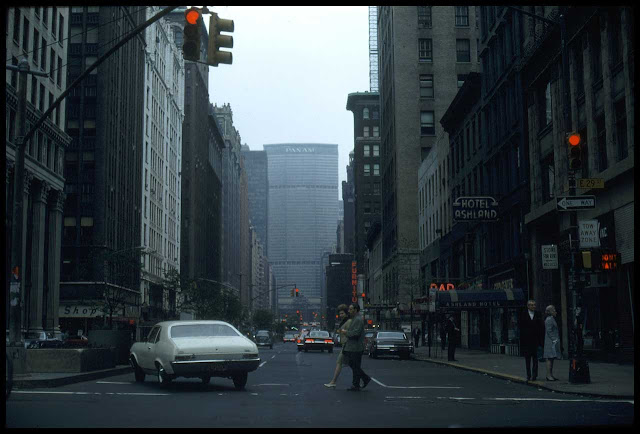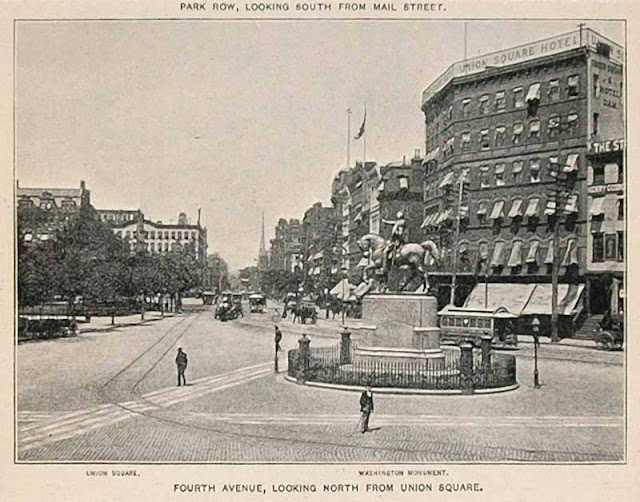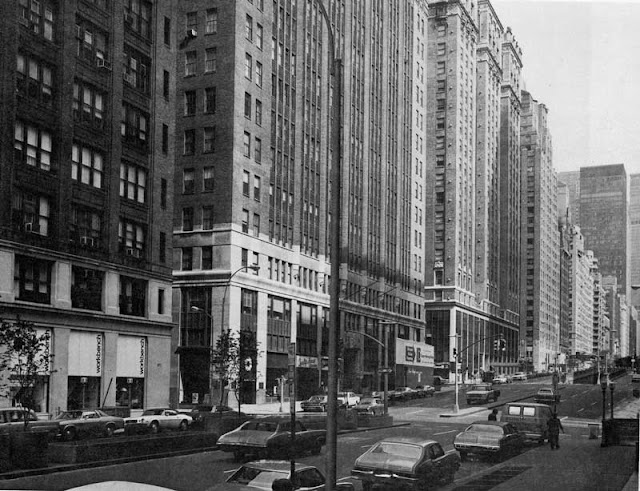Park Avenue South, Manhattan
 |
| Park Avenue South at East 29th Street in 1970. |
Street names can be very confusing in Manhattan because they remain the same for many decades, then suddenly change for little or no reason. Today, we're going to look at one of those streets which has had a more successful name transition than many of the others. Park Avenue South is like the Cinderella of New York Avenues. It gets no respect but always seems on the verge of stardom. When I saw the above picture of Park Avenue South from 1970 with the big Pan Am Building in the distance, I wondered if all that promise and hope over the years had made a big difference. So, I decided to do
a comparison of Park Avenue South from 1970 to 2017.
 |
| Park Avenue South (then Fourth Avenue), looking north from East 31st Street in 1890. The importance of the area is indicated by those newfangled electric poles that were just coming into fashion. The large building is the 1876 Park Avenue Hotel, and the smaller building next to it is the older Brandes Hotel. Note the streetcars coming out of the Park Avenue Tunnel at 33rd Street (from "New York Then and Now," Dover Publications, via Ephemeral New York). |
Park Avenue South runs between East 17th Street (at Union Square) up to East 32nd Street in Manhattan. Above 32nd Street, it is simply Park Avenue. If that seems kind of arbitrary to you, well, it is. There is nothing about East 32nd Street that makes it some kind of marker between north and south other than the fact that the avenue name changes. This brings up the history of the name itself, which is a bit unusual. It was put in the 1811 grid map of the city as Fourth Avenue, which is its natural name given its position directly to the east of Fifth Avenue (at least along some sections, Madison Avenue is between them north of East 23rd Street). It continued happily as Fourth Avenue until 1959, when it was decided to rename it as Park Avenue South. However, only the 15-block stretch between Union Square and East 32nd Street was renamed to Park Avenue South. Below Union Square, it was and remains Fourth Avenue.
 |
| Union Square, looking north toward the future Park Avenue South, 1893 (Halftone Print). |
This is one of those New York oddities where the city decides to rename an avenue for apparently no reason. I don't think anyone will dispute me when I say that "Fourth Avenue" does not have quite the cachet in Manhattan as Fifth Avenue or Third Avenue or Second Avenue. "Fourth Avenue" conjures up images of drab warehouses and 1800s department stores. There is nothing wrong with Fourth Avenue, but obviously, someone with enough clout wanted to separate the area north of Union Square from that name and associate it with the glamorous stretch of avenue north of Grand Central Terminal. The Park Avenue South area was so unfashionable for many years that it didn't even really have a neighborhood name. Everyone knows Greenwich Village and Gramercy and Chelsea and so forth, but Park Avenue South was kind of left out. In the 19th Century, this area was called Rose Hill, and that is still used occasionally. Rose Hill is the area bounded by 23rd Street to the south, 32nd Street to the north, Madison Avenue to the west, and Third Avenue to the east. However, it's still an area without an identity, sandwiched in between Kips Bay and Midtown South and Gramercy.
 |
| The future Park Avenue South at 23rd Street in 1893, showing the National Academy of Design (Halftone Print). |
Sometimes, these name changes don't really stick, such as renaming Sixth Avenue to "Avenue of the Americas" during World War II. However, the name "Park Avenue South" seems to have caught on enough for nobody to still call it Fourth Avenue. This is probably because Park Avenue sounds more prestigious than plain old Fourth Avenue, a name which is tarnished a bit due to its close association with the Bowery. Whatever the reason, it became Park Avenue South and that is how people think of it today.
 |
| Looking north from 21st Street on the future Park Avenue South in 1903. Already, the street's character is changing into a wall of buildings, with construction cranes visible putting up even more tall buildings (Halftone Print). |
In the 1960s and 1970s, though, the new name was not immediately embraced. There were stories of mail being misdelivered and misaddressed and people refusing to call their beloved old Fourth Avenue "Park Avenue South," which made it sound like it was in somebody's basement. However, the name did catch on, though old habits die very hard in New York City and you may still find some old-timers who refuse to call it anything but Fourth Avenue. There also are engravings of "Fourth Avenue" here and there on the old buildings. Manhattan has a long memory.
 |
| Park Avenue South in the 1970s. This was one of the rare streets in Manhattan that had little trees lining its center median. Now, of course, there are trees everywhere in Manhattan (from "New York Then and Now," Dover Publications, via Ephemeral New York). |
Whatever you want to call it, Park Avenue South was hot in the 1920s. That is when many of the buildings that line it were built. These have pretty much remained intact since then, with some additions near Grand Central Terminal. Originally built as office towers, many of these imposing buildings have been converted to coops and condos over the past 30 years. So, though the street may look the same, it actually has changed dramatically in terms of how these buildings are used in the 21st Century.
 |
| Park Avenue South from 29th Street, NYC, November 2017 (Google Street View). |
Now, Park Avenue South is an extremely hot area. Well, okay, at least tepidly hot. It is on the move, baby! It is full of new restaurants and businesses that cater to a completely new and up-and-coming clientele. However, it did not become hot due to the name change or the success of the businesses in those forbidding 1920s office buildings. Instead, all of those pre-war buildings with the big interior spaces turned out to be wonderful living spaces, something the original builders and the city officials who made the name change in 1959 never contemplated. So, instead of the insurance companies and ad agencies that had offices on Park Avenue South in the 1950s, now it is full of multi-million dollar apartments and trendy apartments for young lawyers and designers. That's real change in New York City, the kind you can believe in.
I hope you enjoyed this entry in our "the more things change, the more they stay the same" series. The streets may stay the same, even the buildings may stand for over a hundred years, but the lives of the people that inhabit them make deep and lasting changes in how they are used. Please visit some of our other pages in this series!
2019







No comments:
Post a Comment